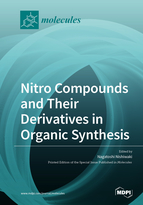Nitro Compounds and Their Derivatives in Organic Synthesis
A special issue of Molecules (ISSN 1420-3049). This special issue belongs to the section "Organic Chemistry".
Deadline for manuscript submissions: closed (30 April 2020) | Viewed by 29103
Special Issue Editor
Interests: organic synthesis; heterocyclic chemistry; synthesis of polyfunctionalized compounds; cycloaddition; nitro chemistry; pseudo-intramolecular proces
Special Issue Information
Dear Colleagues,
Nitro compounds constitute a large family among organic compounds and are widely used for various purposes. The versatility of these compounds is largely due to the diverse properties of their nitro functionality. Nitro groups considerably decrease electron density of the scaffold framework by both inductive and resonance electron-withdrawing effects to facilitate reactions with nucleophiles or transfer of single electron. The α-hydrogen of a nitro group is highly acidic, leading to a stable nitronate anion, which facilitates reactions of nitroalkanes with both electrophilic and nucleophilic reagents. Nitro groups also assist the cleavage of an adjacent carbon–carbon bond. Furthermore, nitro groups can be transformed into versatile functional groups. Despite the substantial contributions of many researchers to nitro chemistry, the chemistry of nitro groups is still an exciting and challenging research area. Thanks to the open access platform, this Special Issue will be an open forum where researchers may share their investigations and findings in this promising field. Contributions to this issue, both in the form of original research or review articles, may cover all aspects of organic synthesis using a nitro group; papers addressing the development of functional materials such as medicines and fluorescence compounds, are particularly welcome.
Prof. Nagatoshi Nishiwaki
Guest Editor
Manuscript Submission Information
Manuscripts should be submitted online at www.mdpi.com by registering and logging in to this website. Once you are registered, click here to go to the submission form. Manuscripts can be submitted until the deadline. All submissions that pass pre-check are peer-reviewed. Accepted papers will be published continuously in the journal (as soon as accepted) and will be listed together on the special issue website. Research articles, review articles as well as short communications are invited. For planned papers, a title and short abstract (about 100 words) can be sent to the Editorial Office for announcement on this website.
Submitted manuscripts should not have been published previously, nor be under consideration for publication elsewhere (except conference proceedings papers). All manuscripts are thoroughly refereed through a single-blind peer-review process. A guide for authors and other relevant information for submission of manuscripts is available on the Instructions for Authors page. Molecules is an international peer-reviewed open access semimonthly journal published by MDPI.
Please visit the Instructions for Authors page before submitting a manuscript. The Article Processing Charge (APC) for publication in this open access journal is 2700 CHF (Swiss Francs). Submitted papers should be well formatted and use good English. Authors may use MDPI's English editing service prior to publication or during author revisions.
Keywords
- Nitro compounds
- Organic synthesis
- Michael acceptor
- Cycloaddition
- Cross-coupling
- Chemical transformation
- Safety and handleability
- Functional materials
- Pharmacy
- Fluorescence and quenching







